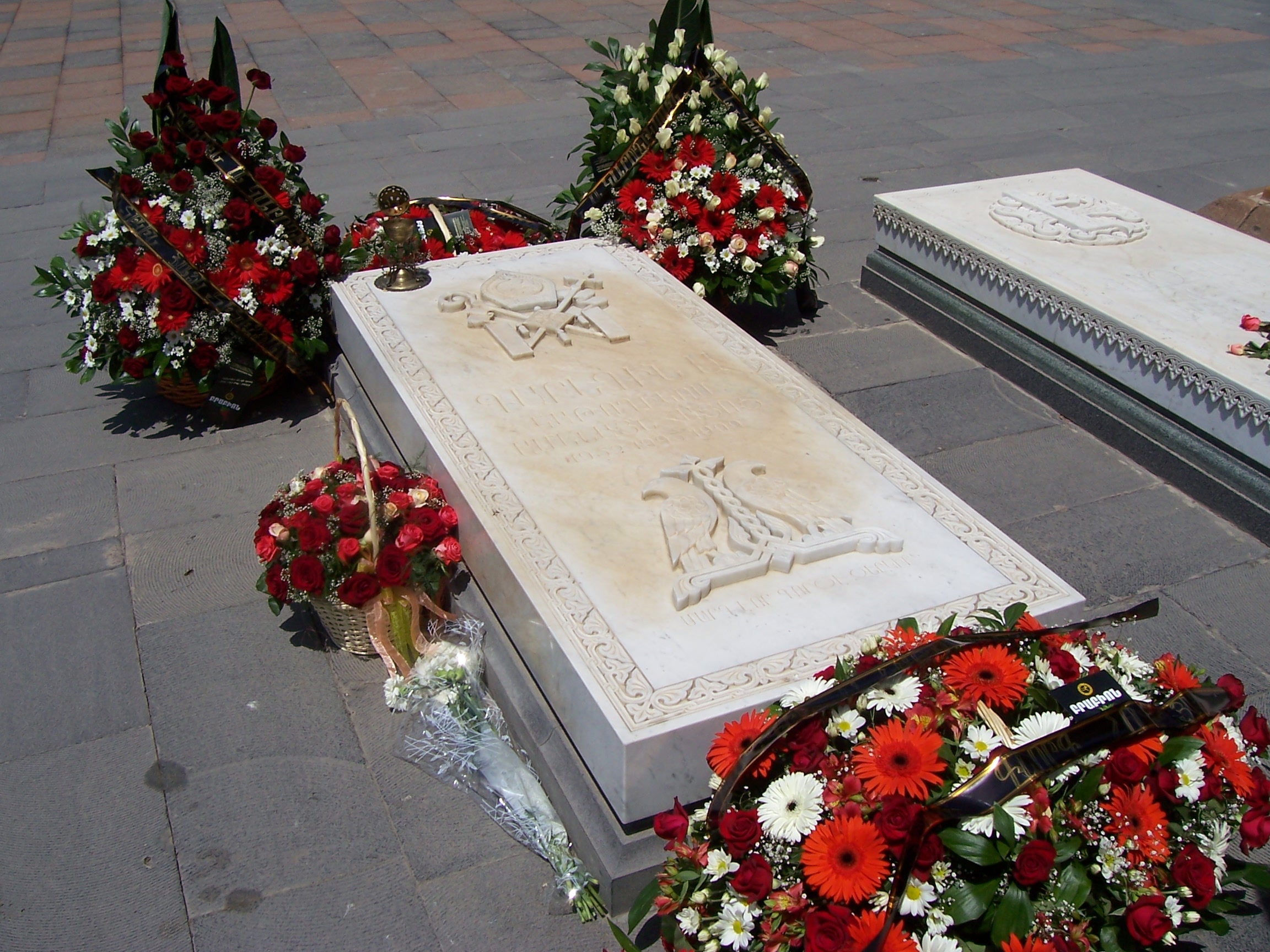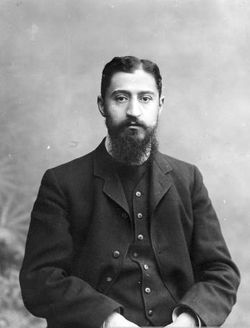|
Catholicos Garegin Hovsepian
Karekin I ( hy, Գարեգին Ա. Յովսէփեանց) (17 December 1867 in Khachisar (now Chardakhlu), Artsakh – 21 June 1952 in Antelias, Lebanon) was a scholar of Armenian art and Catholicos of Cilicia of the Armenian Apostolic Church from 1943 to 1952. Education and career as clergyman Born Garegin Hovsepian and originally from Artsakh (then part of the Elizavetpol Governorate of the Russian Empire), he studied at the Gevorgian Seminary of the Catholicosate of All Armenians in Etchmiadzin (1882-1890). During this period, he was ordained a deacon of the Armenian Church and joined the Congregation of the Holy See of Etchmiadzin. In 1892-1897, he studied theology and philosophy at the universities of Leipzig, Halle and Berlin. His doctoral dissertation was published in Leipzig in 1897. After his return from Germany, Karekin was ordained a celibate priest in Etchmiadzin. In 1917 he was ordained bishop, Until the outbreak of the First World War, he held a number of te ... [...More Info...] [...Related Items...] OR: [Wikipedia] [Google] [Baidu] |
Garegin I Of Cilicia
Garegin (Armenian : Գարեգին), also pronounced Karekin (in Western Armenian), may refer to : Religious figures ;Armenian Catholicoi * Garegin I or Karekin I (1932-1999), a Catholicos of the Armenian Apostolic Church, first as Catholicos Garegin II of the Holy See of Cilicia (1983-1994) and then as Catholicos of All Armenians Garegin I of the Mother See of Holy Etchmiadzin of the Armenian Apostolic Church (1995-1999) * Garegin II or Karekin II (born 1951), Catholicos of All Armenians at the Mother See of Holy Etchmiadzin of the Armenian Apostolic Church * Garegin I (Cilicia) or Karekin I (Cilicia) (1867-1952), a Catholicos of Cilicia of the Armenian Apostolic Church from 1943 to 1952 ;Armenian Patriarchs *Karekin I Khachadourian of Constantinople (1880–1961), the 81st Armenian Patriarch of Constantinople *Karekin II Kazanjian of Constantinople (1927–1998), the 83rd Armenian Patriarch of Constantinople Given name Garegin (Mostly used in Eastern Armenian) * Garegin Khachat ... [...More Info...] [...Related Items...] OR: [Wikipedia] [Google] [Baidu] |
Nakhichevan-on-Don
__NOTOC__ Nakhichevan-on-Don (russian: Нахичевань-на-Дону, ''Naxičevan’-na-Donu''), also known as New Nakhichevan ( hy, Նոր Նախիջևան, ''Nor Naxiĵevan''; as opposed to the "old" Nakhichevan), was an Armenian-populated town near Rostov-on-Don, in southern Russia founded in 1779 by Armenians from Crimea. It retained the status of a city until 1928 when it was merged with Rostov. History left, Monument to alt=f In_the_summer_of_1778,_after_the_Crimean_Khanate.html" ;"title="Gregory the Illuminator">Catherine the Great and the Gregory the Illuminator cathedral on the city's main square">alt=f In the summer of 1778, after the Crimean Khanate">Gregory the Illuminator">Catherine the Great and the Gregory the Illuminator cathedral on the city's main square">alt=f In the summer of 1778, after the Crimean Khanate was made a Russian vassal state, some 12,600 Armenians in Crimea, Armenians of the Crimean peninsula were Population transfer, resettled by General ... [...More Info...] [...Related Items...] OR: [Wikipedia] [Google] [Baidu] |
Zareh I
Zareh I Payaslian ( hy, Զարեհ Ա. Փայասլեան) (14 February 1915, Marash – 18 February 1963, Beirut, Lebanon) was Catholicos of Cilicia of the Armenian Apostolic Church from 1956 to 1963. Life Zareh I was born in 1915, in Marash, Ottoman Empire as Simon Payaslian. Escaping the events of the Armenian genocide, his family moved to Syria, residing in the city of Hama, then in Aleppo. He received his primary education in Mesrobian and Haygazian schools in Aleppo. He received his secondary education in the Jesuit Seminary in Aleppo. Later, he became a graduate of the Antelias Seminary of the Armenian Catholicosate of the Great House of Cilicia. In 1935, he was ordained as a priest and took the name Zareh. He continued his higher education in Belgium between 1937–1940. Starting in 1940, he served in the Armenian prelacy of Aleppo. He became Primate of Aleppo, Syria in 1943 until 1956. in 1946, he founded the Karen Jeppe Armenian College of Aleppo. On 20 February 1956, ... [...More Info...] [...Related Items...] OR: [Wikipedia] [Google] [Baidu] |
Bedros IV Of Cilicia
Bedros IV Sarajian ( hy, Պետրոս Դ. Սարաճյան ) (1870 – 28 September 1940, Beirut) was Catholicos of Cilicia of the Armenian Apostolic Church for only six months during 1940. After his death, the position remained vacant until 1943 when Karekin I Karekin I ( Armenian: ) (August 27, 1932 – June 29, 1999) served as the Catholicos of the Armenian Apostolic Church between 1994 and 1999. Previously, he served as the Catholicos of Cilicia from 1983 to 1994 as Karekin II ( Armenian: ). ... of Cilicia was elected. Bedros had been Armenian Prelate of Cyprus (1899–1905 and 1921–1940) and Armenian Prelate of Hadjin (1910–1915), before becoming Co-Adjutor Catholicos of Cilicia (1936–1940) and eventually was elected as Catholicos in 1940. Source: Avakian, Arra S. (1998). ''Armenia: A Journey Through History''. The Electric Press, Fresno. Catholicoi of Cilicia 1870 births 1940 deaths Armenian Oriental Orthodox Christians Armenian Apostolic C ... [...More Info...] [...Related Items...] OR: [Wikipedia] [Google] [Baidu] |
Karekin I
Karekin I ( Armenian: ) (August 27, 1932 – June 29, 1999) served as the Catholicos of the Armenian Apostolic Church between 1994 and 1999. Previously, he served as the Catholicos of Cilicia from 1983 to 1994 as Karekin II ( Armenian: ). Beginnings Karekin, born and baptized as Neshan Sarkissian, was born in the Armenian-populated village of Kesab in northern Syria, where he attended the Armenian elementary school. In 1946 he was admitted to the Theological Seminary of the Armenian Catholicosate of Cilicia and in 1949 ordained a deacon. In 1952, after having graduated with high honors, he was ordained a celibate priest and took the ecclesiastical name Karekin. He joined the order of the Armenian Catholicosate of Cilicia. In 1955, he presented his doctoral thesis on the subject "The Theology of the Armenian Church, According to Liturgical Hymns Sharakans" and was promoted to the ecclesiastical degree of vardapet (archimandrite). In next year he served as a member of the fa ... [...More Info...] [...Related Items...] OR: [Wikipedia] [Google] [Baidu] |
Armenian Patriarchate In Jerusalem
The Armenian Patriarchate of Jerusalem also known as the Armenian Patriarchate of Saint James ( hy, Առաքելական Աթոռ Սրբոց Յակովբեանց Յերուսաղեմ, , ) is located in the Armenian Quarter of Jerusalem. The Armenian Apostolic Church is officially recognised under Israel's confessional system, for the self-regulation of status issues, such as marriage and divorce. Archbishop Nourhan Manougian, previously the Grand Sacristan and the Patriarchal Vicar, became the 97th Armenian Patriarch of Jerusalem on January 24, 2013. Manougian succeeded Archbishop Torkom Manoogian, who died on October 12, 2012, after serving 22 years in the office. The Patriarch, along with a synod of seven clergymen elected by the St. James Brotherhood, oversees the Patriarchate's operations. During World War I, survivors of the Armenian genocide received shelter in the Armenian convent in Jerusalem. The Armenian population of Jerusalem reached at that time 25,000 people. ... [...More Info...] [...Related Items...] OR: [Wikipedia] [Google] [Baidu] |
Armenian Language
Armenian ( classical: , reformed: , , ) is an Indo-European language and an independent branch of that family of languages. It is the official language of Armenia. Historically spoken in the Armenian Highlands, today Armenian is widely spoken throughout the Armenian diaspora. Armenian is written in its own writing system, the Armenian alphabet, introduced in 405 AD by the priest Mesrop Mashtots. The total number of Armenian speakers worldwide is estimated between 5 and 7 million. History Classification and origins Armenian is an independent branch of the Indo-European languages. It is of interest to linguists for its distinctive phonological changes within that family. Armenian exhibits more satemization than centumization, although it is not classified as belonging to either of these subgroups. Some linguists tentatively conclude that Armenian, Greek (and Phrygian) and Indo-Iranian were dialectally close to each other;''Handbook of Formal Languages'' (1997p. 6 wit ... [...More Info...] [...Related Items...] OR: [Wikipedia] [Google] [Baidu] |
Yerevan State University
Yerevan State University (YSU; hy, Երևանի Պետական Համալսարան, ԵՊՀ, ''Yerevani Petakan Hamalsaran''), also simply University of Yerevan, is the oldest continuously operating public university in Armenia. Founded in 1919, it is the largest university in the country. It is thus informally known as Armenia's "mother university" (Մայր ԲՈւՀ, ''Mayr Buh''). Of its 3,150 employees, 1,190 comprise the teaching staff, which includes 25 academicians, 130 professors, 700 docents (associate professors), and 360 assistant lecturers. The university has 400 researchers, 1,350 post-graduate students, and 8,500 undergraduates, including 300 students from abroad. Instruction is in Armenian, but instruction in Russian or English for foreign students is available as needed. The academic year is from September 1 through June 30. According to University Ranking by Academic Performance (URAP), it was the top-ranked university in Armenia and the 954th in the world in 2 ... [...More Info...] [...Related Items...] OR: [Wikipedia] [Google] [Baidu] |
First Republic Of Armenia
The First Republic of Armenia, officially known at the time of its existence as the Republic of Armenia ( hy, Հայաստանի Հանրապետութիւն), was the first modern Armenian state since the loss of Armenian statehood in the Middle Ages. The republic was established in the Armenian-populated territories of the disintegrated Russian Empire, known as Eastern Armenia or Russian Armenia. The leaders of the government came mostly from the Armenian Revolutionary Federation (ARF or Dashnaktsutyun). The First Republic of Armenia bordered the Democratic Republic of Georgia to the north, the Ottoman Empire to the west, Persia to the south, and the Azerbaijan Democratic Republic to the east. It had a total land area of roughly 70,000 km2, and a population of 1.3 million. The Armenian National Council declared the independence of Armenia on 28 May 1918. From its very onset, Armenia was plagued with a variety of domestic and foreign issues. A humanitarian crisis emerged ... [...More Info...] [...Related Items...] OR: [Wikipedia] [Google] [Baidu] |
Armenian Genocide
The Armenian genocide was the systematic destruction of the Armenians in the Ottoman Empire, Armenian people and identity in the Ottoman Empire during World War I. Spearheaded by the ruling Committee of Union and Progress (CUP), it was implemented primarily through the mass murder of around one million Armenians during death marches to the Syrian Desert and the Forced conversion, forced Islamization of Armenian women and children. Before World War I, Armenians occupied a protected, but subordinate, place in Ottoman society. Large-scale massacres of Armenians occurred Hamidian massacres, in the 1890s and Adana massacre, 1909. The Ottoman Empire suffered a series of military defeats and territorial losses—especially the 1912–1913 Balkan Wars—leading to fear among CUP leaders that the Armenians, whose homeland in the eastern provinces was viewed as the heartland of the Turkish nation, would seek independence. During their invasion of Caucasus campaign, Russian and Per ... [...More Info...] [...Related Items...] OR: [Wikipedia] [Google] [Baidu] |
Russian Imperial Archeological Society
The Imperial Russian Archaeological Society (Императорское Русское археологическое общество), originally known as the Archaeological-Numismatic Society, was an archaeological society in the Russian Empire. It was founded in St. Petersburg in 1846. Selected publications * Первый отчет Археологическо-нумизматического общества в Санкт-Петербурге. Заседания 1-5. — СПб., 1847. * Mémoires de la société archéologique et de numismatique de St.-Petersburg (1847–1852). — Вып. 1—6. * Перечень трудов и действий С.-Петербургского археологическо-нумизматического общества с половины 1846 по 1 генваря 1849 года. — СПб., 1849. * Записки Санкт-Петербургского археолого-нумизматического общества (1847–1858) ... [...More Info...] [...Related Items...] OR: [Wikipedia] [Google] [Baidu] |

_(1811).png)





